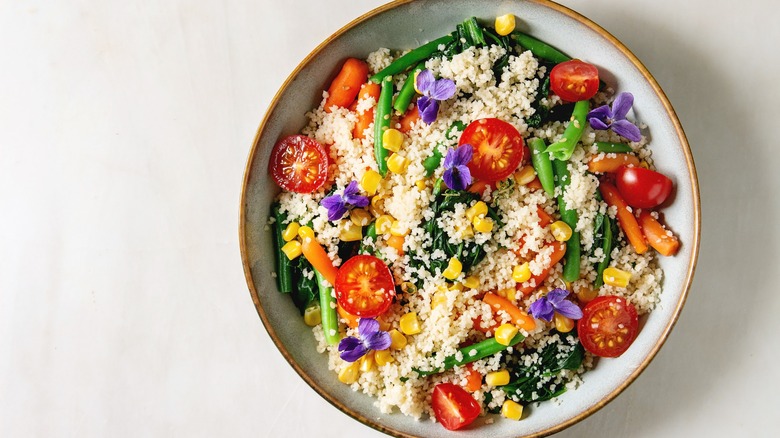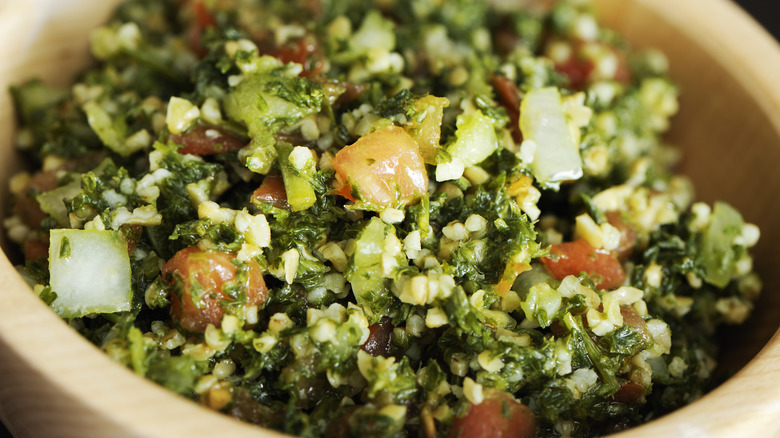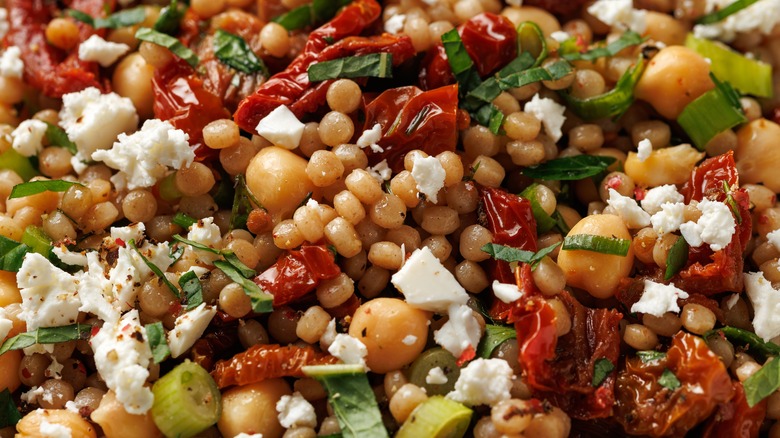Pasta Or Grain: Where Does Couscous Really Belong?
Couscous makes for a really versatile ingredient since those tiny starchy beads can be tossed with nearly anything, including air-fired harissa mushrooms. You can use it for a side dish or even as the main ingredient in a one-bowl meal, and since it's a blank canvas in terms of flavor, you can season it with practically anything. But there's one thing that stumps people about what couscous actually is. Since those little spheres are so uniformly small, it's easy to assume that they're a grain harvested from a plant like quinoa, but the truth is that couscous is a form of pasta. It's made from a dough of semolina flour and water that's then rolled, creating individual pieces with irregular shapes (look very carefully at a few grains to see what I'm talking about). And there are multiple varieties of it, too — if you zoom in on the ones with larger, more spherical beads, such as pearl couscous, it makes it much more apparent that it's not a grain at all.
Bulgur is not the same as couscous
It's possible the confusion lies in couscous' resemblance to a similarly-shaped ingredient, bulgur. Bulgur comes from whole-grain wheat and is a diminutive size that you see tossed into popular dishes like tabbouleh. It's made of parboiled wheat groats that have been dried out and then ground, which creates its small size. Because it's also wheat-based, like couscous (since it's actual wheat), you can use it in the same way.
That being said, you can also use bulgur in other applications where a tiny pasta like couscous might not hold up as well, like in soup, and it has a more nutty flavor compared to a neutral one, such as couscous. Then there's the difference in its nutritional makeup. Since bulgur comes from whole grain, it also provides you with dietary fiber along with the nutrients you get from a whole wheat product, such as iron and vitamin B6. And one added bonus: Because it's parboiled, bulgur can be prepared quickly since you're not preparing it from a fully raw state. We're firm believers that ancient grains can be pretty handy in the pantry.
Couscous comes in many varieties
Just like all pasta, couscous comes in multiple varieties. When you think of couscous, I'm guessing most think of the tiny kind, which is Moroccan couscous. Then there's its larger-sized cousin, known as pearl or Israeli couscous, which has a bouncier chew to it and sometimes comes in a tri-color version (adding green and red to the mix), as well as the largest version of all, Lebanese couscous.
Cooking time depends on the variety. As you can imagine, the bigger the pasta piece, the longer it'll take to cook since the material within is essentially straight-dried flour. But fortunately, once it's done cooking, you're good to go. Couscous makes for a great base ingredient for a large format side dish, so if you're headed to a potluck, you can start with a big batch of it, toss in some chopped vegetables, fresh herbs, and maybe a little bit of crumbly cheese, and dress it up with a vinaigrette. Suddenly, you've got a relatively low-labor dish packed with plenty of bright flavors, and nobody'll know how easy it was to put together.
And now that you know that couscous isn't a grain but a pasta, you also have a little tidbit you can whip out during casual conversation. Or if you go the bulgur route, you can extoll upon its virtues too, and how it's not, in fact, Moroccan couscous. Who'd have thought a tiny piece of pasta was so interesting?


